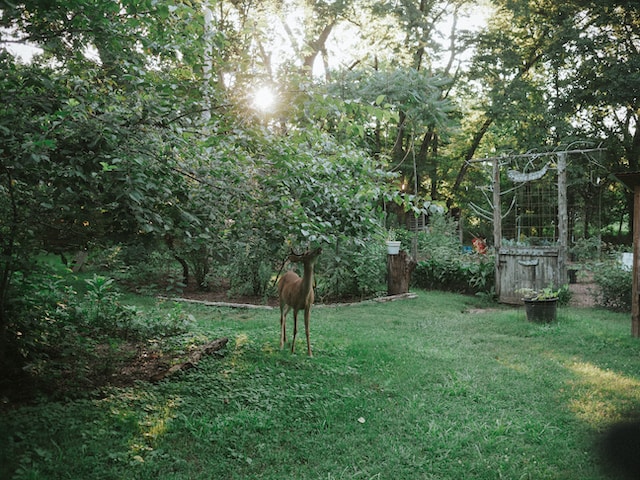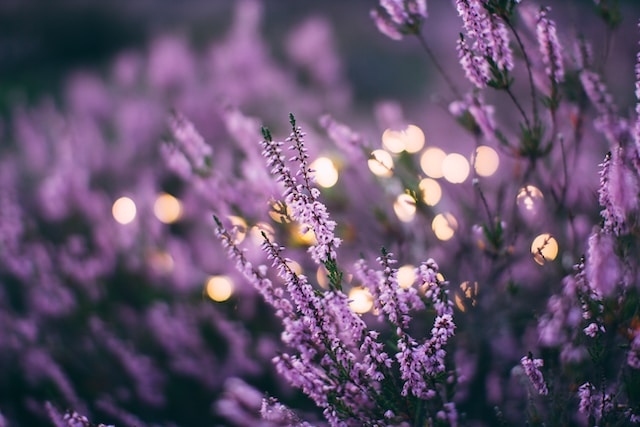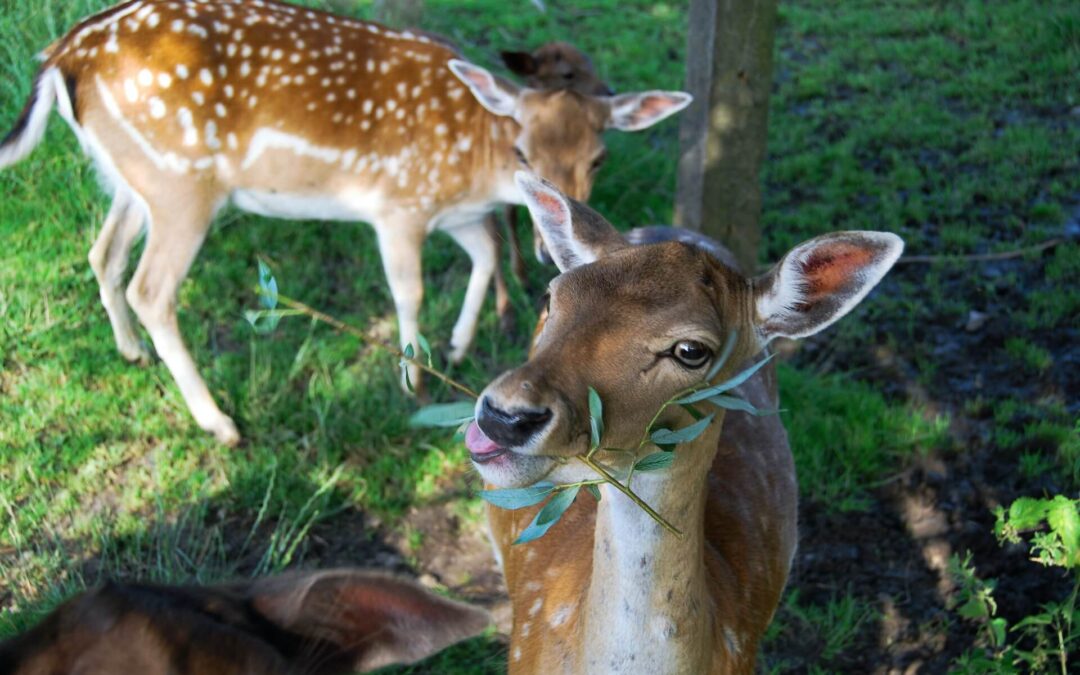Deer. They’re a lovely sight, until they are in your yard eating your landscaping. Unfortunately, deer can be hard to manage and keep out, but let’s take a look at strategies you can implement to keep your landscaping looking lovely.
Controlling the numbers of deer is, of course, challenging in a city. Because of this, the only way to protect your yard from deer is through proper landscaping to discourage their presence.
Understanding The Deer Problem
Deer are versatile browsers. Whitetails, however, require higher quality forage than, say, cattle or elk. Despite this, they have been known to eat over 400 species of plants! Most of their diet, however, consists of three things:
- Browse, which is the leaves of trees or bushes
- Forbs, herbaceous broad-leaved plants, including your lettuce
- Mast, which means seeds and fruit. White tails can eat more acorns than many species and have a high tolerance for tannins.
Part of the problem is that the kind of high quality forage whitetails need is…also the kind of high quality forage we put in salads. When they can get them, whitetails strongly prefer agricultural crops, which are easily digestible and tend to be palatable. Basically, deer like lettuce and spinach too. This puts us in competition with the deer for leafy vegetables.
Deer can also damage young trees and plants you are growing for their appearance. When not regularly hunted, they tend not to be particularly afraid of humans. While deer are non-confrontational, they aren’t always easy to chase off.
This means that deer are a major cause of damage to landscaping and gardens in the Bloomington area. They eat some plants and trample others, and are not above eating seeds you planted or the fruit from an apple tree. As far as the deer are concerned, your garden is a buffet.

Deer Resistant Plant Selection
One way to protect your decorative plants is to select deer-resistant plants. This basically means plants that the deer are less likely to eat. By planting things deerdon’t find tasty, you will encourage them to go forage elsewhere.
The City of Bloomington Environmental Commission provides a list of native plants that will not attract deer. Native plants are also more tolerant of being nibbled on than imports from areas that don’t natively have whitetails.
There are a couple of other ways you can make your plantings resist deer:
- Aromatic plants. Deer simply do not like the smell of some plants. Culinary herbs are a good choice. Plant them in amongst your lettuce and then, of course, you have herbs. Deer dislike the scent of sage, rosemary, oregano, mint, thyme, dill, catnip, and lavender. Choose trees and shrubs such as junipers, sagebrush, and fragrant sumac. Any strong-smelling plant will help.
- Thorny plants. Plants grow thorns to keep off browsers, including deer. You can deploy these natural defenses by planting thorny or prickly plants around the perimeter of your garden.
Come up with a landscape design that puts deer-resistant plants on the outside of your garden, forming a perimeter to protect the tasty ones. Be aware that deer can sometimes become resistant in a specific area. Your deer-resistant garden plan should also include barriers. Avoid plants deer particularly like, such as hostas and azaleas.

Lavender is a great example of an aromatic plant that repels deer, but which also looks lovely in your landscaping.
Fencing & Barriers To Prevent Deer
One of the issues with keeping deer out is a simple one: They jump. To keep deer out, your fence has to be eight feet high and/or slanted outwards to deter jumping. Snow fencing can work around a small plot. Note that Bloomington does not allow fences higher than 8′ in a backyard and 4′ in a front yard. So a deer fence should be exactly eight feet high. You are also not allowed to use electrified fences.
Netting over plants and trellises can also keep away deer. Netting is also reasonably effective against rabbits, so it’s a good idea to net high-value crops. Young trees should be protected with tree wrap, which prevents the deer from eating them while they are small enough that deer damage can kill them.
Keeping deer out with barriers alone is not often feasible.
Deterrents and Repellents
Deer repellent can be very useful. In addition to the aromatic plants mentioned above, you can use both commercial and DIY deer repellents.
- Commercial deer repellent. This can come in both spray and granular form. Make sure to choose a deer repellent rated to repel whitetails. Deerrepellent usually mimics compounds that emit sulfurous odors, which smell like predators to a deer, or capsaicin-based repellents. Bittering agents tend not to work as well on deer. Repellents are applied or attached directly to the plant.
- DIY deer repellent. These are often less toxic than commercial options. You can use strongly scented soap, especially lavender soap, or a spray made out of eggs and milk allowed to spoil. Peppermint and rosemary essential oil in vinegar also works well.
- Other deterrent options. Deer avoid humans, so sometimes putting bags of cut hair by your plants will make them go elsewhere. Bloodmeal spread within 30″ of the damage works for a short while, but can attract foxes and other carnivores.
Garden Design and Layout
Deer-resistant garden design combines a variety of factors. You should consider:
- Strategic location of deer-resistant plants to make a barrier between the deer and tasty plant. Group plants with similar resistance levels.
- Making a sacrifice area. This means planting what the deer do like, then making it hard for them to get to your actual kitchen garden. The deer will eat the sacrifice plants and leave the rest of your yard alone.
- Incorporating vertical elements such as raised beds, which can make it harder for deer to get to the plants.
Remember that repelled deer are going to go somewhere. A sacrifice bed means they are less likely to come back or eat a neighbor’s salad instead.
Maintenance and Monitoring
You need to keep your garden deer free. The first part is to monitor for deer damage. If damage increases and you’re using repellents, then likely the deer have got used to them and you may need to switch things up.
Keep your plants properly pruned. This discourages browsing as well as ensuring the health of your plants. Bear in mind that deer behavior is seasonal. For example, deer eat more seeds in the fall in preparation for winter, and are likely to come investigate oak trees or similar.
Community and Legal Considerations
It is illegal to intentionally feed deer in Bloomington. Don’t put out a feeder to tempt deer away from your plants. You also cannot use firearms for lethal deer control.
Coordinating with your neighbors can help, otherwise you will be chasing deer into each other’s gardens, causing conflict. High anti-deer fencing can also cause problems with neighbors, especially if its opaque. On the other hand, trading strategies can help everyone keep the deer out.
If needed, seek professional help with landscaping to keep deer out of your yard.
Conclusion
Bloomington, IN has a deer problem. Be part of the solution by creating beautiful deer-resistant landscaping that discourages deer from sticking around.
By choosing deer-resistant plants such as thorny plants and aromatic herbs, appropriately using barriers, and the proper use of repellents, you can keep deer out of your yard and keep your lettuce for yourself. For professional help, contact Anthony’s Lawn Care & Landscaping today.
You can also check out another of Anthony’s Lawncare posts that covers plants that keep rabbit and deer out of your garden.
Additional Deer &Landscaping Resources
- List of deer-resistant native plants: https://bloomington.in.gov/sites/default/files/2017-08/Natural%20Landscaping%20–%20Deer-resistant%20native%20plant%20species.pdf
- Results of the 2011 Bloomington Deer Task Force: https://bloomington.in.gov/boards/deertaskforce
- Deer-Resistant Design: Fence-free Gardens that Thrive Despite the Deer: https://www.amazon.com/Deer-Resistant-Design-Fence-free-Gardens-Despite/dp/1604698497


Recent Comments